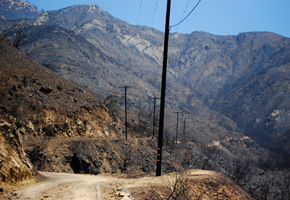 To be sure, the city of Santa Barbara’s hiking-friendly front country has been transformed into a moonscape of desolate land and devastated trails as a result of the Jesusita Fire.
To be sure, the city of Santa Barbara’s hiking-friendly front country has been transformed into a moonscape of desolate land and devastated trails as a result of the Jesusita Fire.
As of Wednesday the US Forest Service lifted its closure of the burn area, yet the Jesusita Trail, Tunnel Road Trail, and Rattlesnake Canyon Trail – under the jurisdiction of the County Parks and Recreation Department – remain closed indefinitely. The County is keeping the trails closed due to fear of rock slides or trail degradation. No one at the Park and Recreation office could be reached to comment on how long the closures are expected to last.
While the damage to homes is widely known, my burning and unanswered question was to what extent the trails and associated flora and fauna had suffered. Taking advantage of media privileges, I took a quick jaunt up to the top of Inspiration Point the other day to see just how bad it was.
Like most Santa Barbara residents, I followed the local news websites appalled by the fire’s appetite, but photos do not even begin to tell the tale of destruction. A drive through the burn area is punctuated by sights of burned trees, fences, and houses seemingly picked at random for destruction.
The trailhead at the top of Tunnel Road is a desolate landscape. The charred remains of Chaparral stand like tombstones on the blackened earth. It seems as though nothing has been spared.
 The first half of the hike to Inspiration Point suffered the worst with virtually nothing left except for some old Oaks; the extensive groves of brush that once lined the trail no longer exist making for a warmer and less shady hike.
The first half of the hike to Inspiration Point suffered the worst with virtually nothing left except for some old Oaks; the extensive groves of brush that once lined the trail no longer exist making for a warmer and less shady hike.
The most prevalent damage to the trails is in the form of fallen branches and brush. Many bushes were stripped of their leaves and weakened by the fire so that they are toppled over obstructing the path.
There are also several small scale rock slides from the steep hills above. Luckily, none of these appear to be so significant that they can not be repaired. The long range issue is how much of the vegetation will grow back before next winter to prevent mud slides on the trails and in the canyons.
I did not venture all the way up the canyon towards Seven Falls yet it looked as though it had been spared. It seems like the steepness of the canyon only allowed the fire to burn half way down before jumping to the other side and continuing on.
Reptilian life faired much better then the plants. Soil is surprisingly resistant to heat, so those that were able to hide underground escaped the wrath of the Jesusita blaze. Lizards can be found scurrying around everywhere, and I even saw a California King Snake a few feet from the path.
Though the land seems desolate now, as soon as the moisture of fall and winter arrives, grasses will be stimulated back to life. The hills of our region are meant to burn, and the area of the Jesusita blaze was long overdue. As a good sign of nature’s resilience I saw a shoot of new grass emerging from beneath a rock. The burn area will return to its former majesty in due time, patience is all that is needed.
